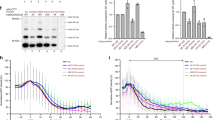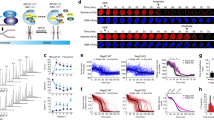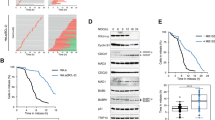Abstract
Eukaryotic cells rely on a surveillance mechanism known as the spindle checkpoint to ensure accurate chromosome segregation. The spindle checkpoint prevents sister chromatids from separating until all kinetochores achieve bipolar attachments to the mitotic spindle1,2,3. Checkpoint proteins tightly inhibit the anaphase-promoting complex (APC), a ubiquitin ligase required for chromosome segregation and progression to anaphase. Unattached kinetochores promote the binding of checkpoint proteins Mad2 and BubR1 to the APC-activator Cdc20, rendering it unable to activate APC. Once all kinetochores are properly attached, however, cells inactivate the checkpoint within minutes, allowing for the rapid and synchronous segregation of chromosomes4. How cells switch from strong APC inhibition before kinetochore attachment to rapid APC activation once attachment is complete remains a mystery. Here we show that checkpoint inactivation is an energy-consuming process involving APC-dependent multi-ubiquitination. Multi-ubiquitination by APC leads to the dissociation of Mad2 and BubR1 from Cdc20, a process that is reversed by a Cdc20-directed de-ubiquitinating enzyme5. The mutual regulation between checkpoint proteins and APC leaves the cell poised for rapid checkpoint inactivation and ensures that chromosome segregation promptly follows the completion of kinetochore attachment. In addition, our results suggest a mechanistic basis for how cancer cells can have a compromised spindle checkpoint without corresponding mutations in checkpoint genes6.
This is a preview of subscription content, access via your institution
Access options
Subscribe to this journal
Receive 51 print issues and online access
$199.00 per year
only $3.90 per issue
Buy this article
- Purchase on Springer Link
- Instant access to full article PDF
Prices may be subject to local taxes which are calculated during checkout




Similar content being viewed by others
References
Yu, H. Regulation of APC–Cdc20 by the spindle checkpoint. Curr. Opin. Cell Biol. 14, 706–714 (2002)
Musacchio, A. & Hardwick, K. G. The spindle checkpoint: structural insights into dynamic signalling. Nature Rev. Mol. Cell Biol. 3, 731–741 (2002)
Cleveland, D. W., Mao, Y. & Sullivan, K. F. Centromeres and kinetochores: from epigenetics to mitotic checkpoint signaling. Cell 112, 407–421 (2003)
Rieder, C. L. & Maiato, H. Stuck in division or passing through: what happens when cells cannot satisfy the spindle assembly checkpoint. Dev. Cell 7, 637–651 (2004)
Stegmeier, F. et al. Anaphase initiation is regulated by antagonistic ubiquitination and deubiquitination activities. Nature (in the press).
Weaver, B. A. & Cleveland, D. W. Decoding the links between mitosis, cancer, and chemotherapy: The mitotic checkpoint, adaptation, and cell death. Cancer Cell 8, 7–12 (2005)
Rape, M. & Kirschner, M. W. Autonomous regulation of the anaphase-promoting complex couples mitosis to S-phase entry. Nature 432, 588–595 (2004)
Rape, M., Reddy, S. K. & Kirschner, M. W. The processivity of multiubiquitination by the APC determines the order of substrate degradation. Cell 124, 89–103 (2006)
Fang, G. Checkpoint protein BubR1 acts synergistically with Mad2 to inhibit anaphase-promoting complex. Mol. Biol. Cell 13, 755–766 (2002)
Tang, Z., Bharadwaj, R., Li, B. & Yu, H. Mad2-independent inhibition of APCCdc20 by the mitotic checkpoint protein BubR1. Dev. Cell 1, 227–237 (2001)
Hwang, L. H. et al. Budding yeast Cdc20: a target of the spindle checkpoint. Science 279, 1041–1044 (1998)
Sironi, L. et al. Crystal structure of the tetrameric Mad1–Mad2 core complex: implications of a 'safety belt' binding mechanism for the spindle checkpoint. EMBO J. 21, 2496–2506 (2002)
Luo, X., Tang, Z., Rizo, J. & Yu, H. The Mad2 spindle checkpoint protein undergoes similar major conformational changes upon binding to either Mad1 or Cdc20. Mol. Cell 9, 59–71 (2002)
Luo, X. et al. The Mad2 spindle checkpoint protein has two distinct natively folded states. Nature Struct. Mol. Biol. 11, 338–345 (2004)
De Antoni, A. et al. The Mad1/Mad2 complex as a template for Mad2 activation in the spindle assembly checkpoint. Curr. Biol. 15, 214–225 (2005)
Yu, H. Structural activation of Mad2 in the mitotic spindle checkpoint: the two-state Mad2 model versus the Mad2 template model. J. Cell Biol. 173, 153–157 (2006)
Xia, G. et al. Conformation-specific binding of p31comet antagonizes the function of Mad2 in the spindle checkpoint. EMBO J. 23, 3133–3143 (2004)
Mapelli, M. et al. Determinants of conformational dimerization of Mad2 and its inhibition by p31comet. EMBO J. 25, 1273–1284 (2006)
Wagner, K. W. et al. Overexpression, genomic amplification and therapeutic potential of inhibiting the UbcH10 ubiquitin conjugase in human carcinomas of diverse anatomic origin. Oncogene 23, 6621–6629 (2004)
Okamoto, Y. et al. UbcH10 is the cancer-related E2 ubiquitin-conjugating enzyme. Cancer Res. 63, 4167–4173 (2003)
Pallante, P. et al. UbcH10 overexpression may represent a marker of anaplastic thyroid carcinomas. Br. J. Cancer 93, 464–471 (2005)
Tao, W. et al. Induction of apoptosis by an inhibitor of the mitotic kinesin KSP requires both activation of the spindle assembly checkpoint and mitotic slippage. Cancer Cell 8, 49–59 (2005)
Acknowledgements
We are grateful to H. Yu, F. McKeon, R. King and P. Sorger for generous gifts of reagents, and to F. Stegmeier and S. Elledge for sharing results before publication. We thank members of the Kirschner laboratory, especially P. Jorgensen and M. Springer for helpful discussions. We thank P. Jorgensen, J. Son and J. Schaletzky for critical reading of the manuscript. S.K.R. acknowledges the support of the Medical Scientist Training Program. M.R. was supported by an EMBO long-term fellowship and by a fellowship of the Human Frontiers Science Organization. This work was supported by grants from the National Institutes of Health to M.W.K.
Author information
Authors and Affiliations
Corresponding author
Ethics declarations
Competing interests
Reprints and permissions information is available at www.nature.com/reprints. The authors declare no competing financial interests.
Supplementary information
Supplementary Information
This file contains Supplementary Methods and Supplementary Figures S1-S5 with Legends (PDF 508 kb)
Rights and permissions
About this article
Cite this article
Reddy, S., Rape, M., Margansky, W. et al. Ubiquitination by the anaphase-promoting complex drives spindle checkpoint inactivation. Nature 446, 921–925 (2007). https://doi.org/10.1038/nature05734
Received:
Accepted:
Issue Date:
DOI: https://doi.org/10.1038/nature05734
This article is cited by
-
The correlation between the expression of ubiquitin-conjugating enzyme 2C and prostate cancer prognosis
Journal of Cancer Research and Clinical Oncology (2023)
-
Lactate regulates cell cycle by remodelling the anaphase promoting complex
Nature (2023)
-
CENP-F-dependent DRP1 function regulates APC/C activity during oocyte meiosis I
Nature Communications (2022)
-
Mitotic phosphorylation of tumor suppressor DAB2IP maintains spindle assembly checkpoint and chromosomal stability through activating PLK1-Mps1 signal pathway and stabilizing mitotic checkpoint complex
Oncogene (2022)
-
Physiological relevance of post-translational regulation of the spindle assembly checkpoint protein BubR1
Cell & Bioscience (2021)
Comments
By submitting a comment you agree to abide by our Terms and Community Guidelines. If you find something abusive or that does not comply with our terms or guidelines please flag it as inappropriate.



